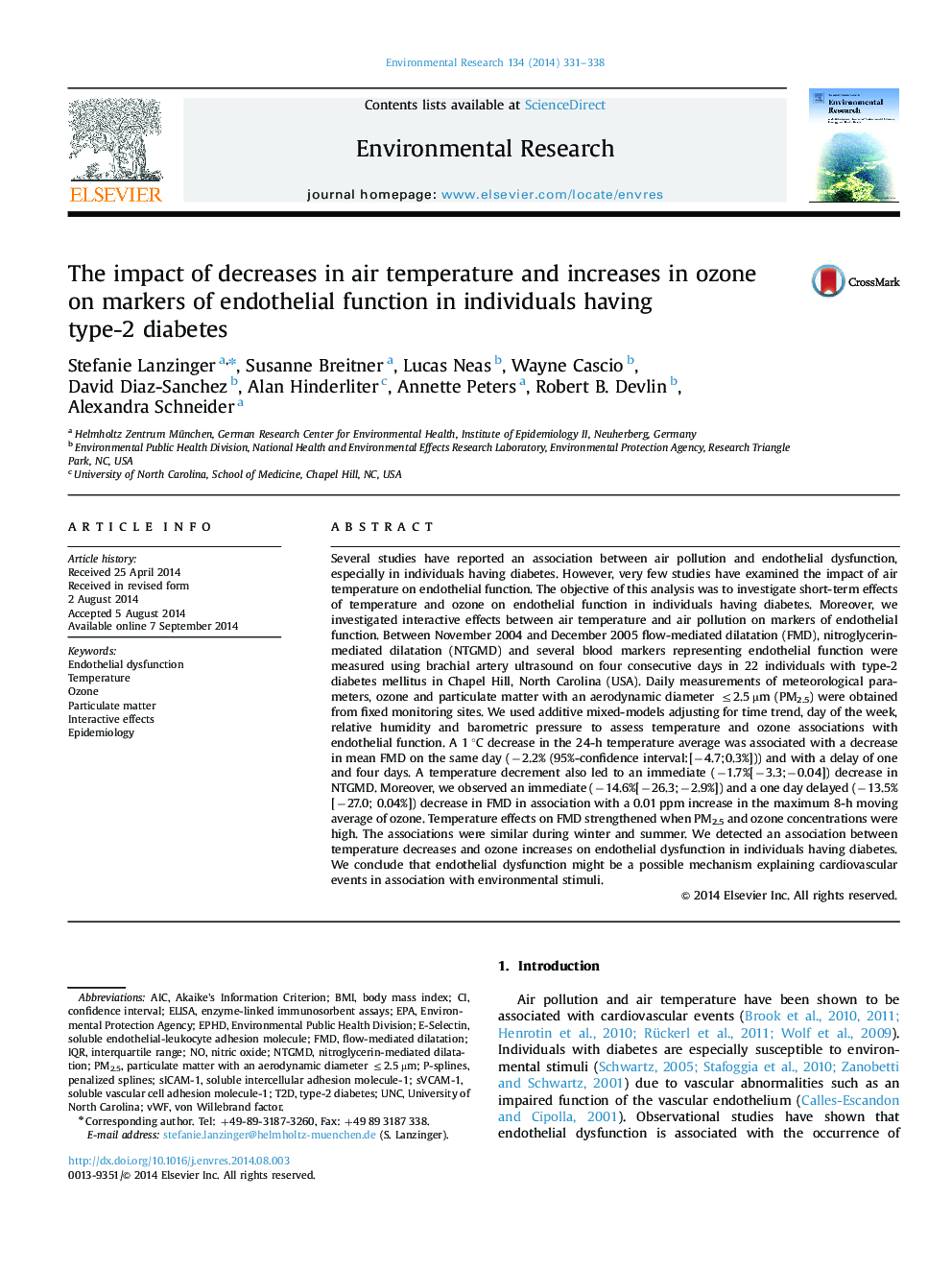| کد مقاله | کد نشریه | سال انتشار | مقاله انگلیسی | نسخه تمام متن |
|---|---|---|---|---|
| 6352493 | 1622567 | 2014 | 8 صفحه PDF | دانلود رایگان |
عنوان انگلیسی مقاله ISI
The impact of decreases in air temperature and increases in ozone on markers of endothelial function in individuals having type-2 diabetes
ترجمه فارسی عنوان
تأثیر کاهش دمای هوا و افزایش میزان ازن در نشانگرهای عملکرد اندوتلیال در افراد مبتلا به دیابت نوع 2
دانلود مقاله + سفارش ترجمه
دانلود مقاله ISI انگلیسی
رایگان برای ایرانیان
کلمات کلیدی
vWFsICAM-1E-selectinsVCAM-1FMDUncT2DIQRAICEPAP-splinesPM2.5enzyme-linked immunosorbent assays - آنزیم های وابسته به ایمنی جذب شدهEnvironmental Protection Agency - آژانس حفاظت از محیط زیستInteractive effects - اثرات تعاملیEndothelial dysfunction - اختلال عملکرد اندوتلیالOzone - اُزون Epidemiology - اپیدمیولوژی(همهگیرشناسی)ELISA - تست الیزاUniversity of North Carolina - دانشگاه کارولینای شمالیTemperature - دماType-2 diabetes - دیابت نوع 2Flow-mediated dilatation - دیلاتاسیون متصل به جریانparticulate matter - ذرات معلقbody mass index - شاخص توده بدنBMI - شاخص توده بدنیPenalized splines - شیلنگ های مجازvon Willebrand factor. - عامل فون ویلبراند.confidence interval - فاصله اطمینانinterquartile range - محدوده بین محدبSoluble intercellular adhesion molecule-1 - مولکول چسبندگی بین سلولی حلقوی-1Soluble vascular cell adhesion molecule-1 - مولکول چسبندگی سلولی عروقی حلقوی-1Nitric oxide - نیتریک اکسید
موضوعات مرتبط
علوم زیستی و بیوفناوری
علوم محیط زیست
بهداشت، سم شناسی و جهش زایی
چکیده انگلیسی
Several studies have reported an association between air pollution and endothelial dysfunction, especially in individuals having diabetes. However, very few studies have examined the impact of air temperature on endothelial function. The objective of this analysis was to investigate short-term effects of temperature and ozone on endothelial function in individuals having diabetes. Moreover, we investigated interactive effects between air temperature and air pollution on markers of endothelial function. Between November 2004 and December 2005 flow-mediated dilatation (FMD), nitroglycerin-mediated dilatation (NTGMD) and several blood markers representing endothelial function were measured using brachial artery ultrasound on four consecutive days in 22 individuals with type-2 diabetes mellitus in Chapel Hill, North Carolina (USA). Daily measurements of meteorological parameters, ozone and particulate matter with an aerodynamic diameter â¤2.5 µm (PM2.5) were obtained from fixed monitoring sites. We used additive mixed-models adjusting for time trend, day of the week, relative humidity and barometric pressure to assess temperature and ozone associations with endothelial function. A 1 °C decrease in the 24-h temperature average was associated with a decrease in mean FMD on the same day (â2.2% (95%-confidence interval:[â4.7;0.3%])) and with a delay of one and four days. A temperature decrement also led to an immediate (â1.7%[â3.3;â0.04]) decrease in NTGMD. Moreover, we observed an immediate (â14.6%[â26.3;â2.9%]) and a one day delayed (â13.5%[â27.0; 0.04%]) decrease in FMD in association with a 0.01 ppm increase in the maximum 8-h moving average of ozone. Temperature effects on FMD strengthened when PM2.5 and ozone concentrations were high. The associations were similar during winter and summer. We detected an association between temperature decreases and ozone increases on endothelial dysfunction in individuals having diabetes. We conclude that endothelial dysfunction might be a possible mechanism explaining cardiovascular events in association with environmental stimuli.
ناشر
Database: Elsevier - ScienceDirect (ساینس دایرکت)
Journal: Environmental Research - Volume 134, October 2014, Pages 331-338
Journal: Environmental Research - Volume 134, October 2014, Pages 331-338
نویسندگان
Stefanie Lanzinger, Susanne Breitner, Lucas Neas, Wayne Cascio, David Diaz-Sanchez, Alan Hinderliter, Annette Peters, Robert B. Devlin, Alexandra Schneider,
